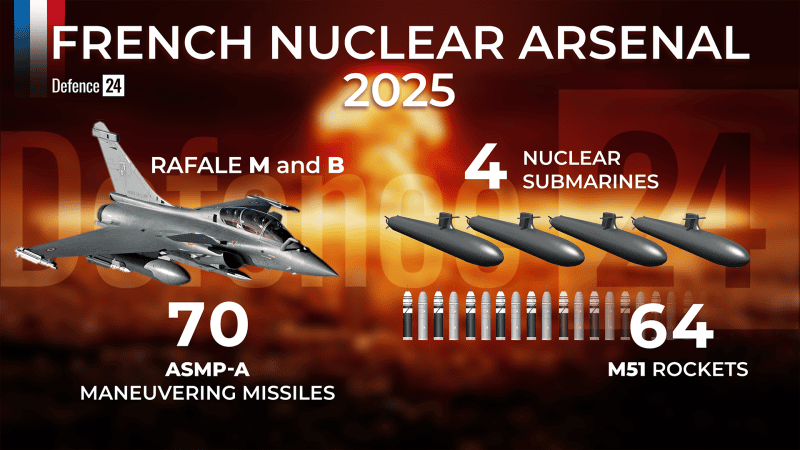The French Nuclear Umbrella for Poland

France has a very long history of nuclear deterrence. The topic has recently returned to the agenda, and allied countries could now be covered by its nuclear umbrella. The initial proposals involve expanding the doctrine—currently limited by the United States to Germany—to include countries such as Poland, the Czech Republic, or the Baltic states. By deploying Rafale fighter jets, Paris could effectively demonstrate its capabilities and engage at a level of competition that the Russian Federation fears.
In response to the evolution of Russia’s nuclear doctrine—particularly the lowering of the nuclear weapons use threshold announced by President Vladimir Putin in November 2024—France’s Minister for Foreign Affairs, Jean-Noël Barrot, dismissed the decision as mere rhetoric. He also assured that the Fifth Republic would not be intimidated by such actions. This message was reinforced at the beginning of March this year by President Emmanuel Macron, who spoke openly about the threats facing France and its citizens, as well as the possibility of extending French nuclear deterrence to the rest of Europe. He expressed hope for cooperation to be achieved by the end of the first half of 2025, following technical discussions with other leaders, including Poland.
A Bit of History
With the advent of the atomic era in 1942 and the intensification of nuclear research, the demand for uranium grew. For France, the solution lay in its former African colonies, primarily Niger and Gabon, which held uranium deposits. France exploited Gabonese uranium reserves between 1957 and 1999, ceasing operations when raw material prices fell on the market. Today, it imports uranium from Kazakhstan, Australia, and Uzbekistan, while still having some reserves in Niger. However, relations with Niger were completely severed following the coup in July 2023. France’s next major investment in uranium mining will be in Mongolia, where agreements have already been signed.
France’s nuclear doctrine is based on the principle of strategic deterrence, established in the 1960s under the leadership of General de Gaulle. The doctrine rests on the idea that any aggression against France would be too costly for an adversary due to the threat of nuclear retaliation.
Since 1996, France has not maintained a classic nuclear triad, having dismantled its S3 land-based ballistic missiles at Plateau d’Albion. As the name suggests, a nuclear triad consists of three components—sea, land, and air—meaning that the nuclear arsenal is comprised of thermonuclear warhead-equipped missiles launched from submarines, aircraft, and land-based launchers.
French Nuclear Arsenal in 2025
In 2025, France possesses approximately 290 nuclear warheads, deployed across two main pillars of its nuclear arsenal.
The first of these consists of M51 ballistic missiles, which are carried by four nuclear-powered submarines of theLe Triomphant class. Each of these submarines is armed with 16 M51 ballistic missiles, capable of carrying multiple nuclear warheads, amounting to a total of 64 M51 missiles.
Submarine-Launched Ballistic Missiles (SLBMs) of the M51 type have a range of up to 10,000 km. Each submarine can carry up to 16 of these missiles, and each missile can be equipped with up to 10 independently targetable thermonuclear warheads (typically 4–6 warheads), each with a yield of at least 100 kilotons.
The four nuclear submarinesLe Triomphant, Le Téméraire, Le Vigilant, andLe Terrible—are powered by K15 reactors with a thermal power output of 150 megawatts. They measure 138 metres in length and have a submerged displacement of 12,500 tonnes. Each submarine operates with a crew of 111 sailors and is considered one of the most highly trained submarine units in the world.
The second pillar consists of ASMP-A missiles, used by Rafale B fighter jets of the Air Force and Rafale M jets of the Navy. It is estimated that France possesses around 70 of these missiles.
The fighter jets are equipped with medium-range ASMP-A cruise missiles Air-Sol Moyenne Portée-Amélioré), which carry a TN 81 nuclear warhead with an adjustable yield ranging from 100 to 300 kilotons and a range of 500 km. Their use is planned for escalatory phases of a conflict, where they could serve as tactical nuclear strike weapons.
In November 2023, France conducted a test of the new M51-3 ballistic missile, highlighting the continued development of its strategic nuclear deterrence forces. The M51-3 is the latest version of France’s submarine-launched ballistic missile, designed for deployment on submarines. Compared to its predecessors, it features an extended range by several hundred kilometres, improved penetration capabilities against missile defence systems, and enhanced deterrence effectiveness.
The new missile version is set to be deployed alongside future third-generation SNLE 3G submarines, which are scheduled to enter service by 2035.
Deterrence = Reaction?
France does not renounce the right to use nuclear weapons first, including against states that threaten France’s vital interests. Such a case would include an attack or the threat of an attack on an allied EU member state. This is known asultime avertissement (ultimate warning). It is in line with France’s nuclear doctrine, which allows for a one-time nuclear strike in self-defence as a final warning. If this measure fails, the next phase would involve a full-scale nuclear attack on the most critical military targets and likely also population centres in the adversary’s territory.
One of the pillars of France’s doctrine is strategic independence, even within NATO, as France makes decisions regarding its nuclear arsenal entirely autonomously. This stems from the political thinking of Charles de Gaulle and the strategic concepts of General Pierre Marie Gallois, who, learning from the experiences of the Third and Fourth Republics, promoted autonomy and sovereignty in France’s security policy during the Cold War.
Thus, when France left NATO’s integrated military structures in 1966, it also withdrew from the Nuclear Planning Group (NPG). Its return to NATO’s military structures under President Nicolas Sarkozy in 2009 did not include reintegration into the NPG, meaning France’sforce de frappe (nuclear strike force) remains independent from NATO’s and the United States« nuclear deterrence.
However, this is considered a positive factor by Washington, Paris, and NATO as a whole, as it enhances strategic ambiguity and strengthens deterrence. France’s nuclear strategy also includes the concept of a „final warning”, meaning that in a situation of critical threat to the French nation, France would consider a limited nuclear strike to demonstrate its determination.
The term „vital interests” emerged during the Cold War and referred to a rhetorical and operational concept of de-escalation through escalation in the event of a Warsaw Pact military invasion of West Germany and the Benelux countries from East German territory. Macron’s rhetoric also refers to vital interests, but they have now been expanded to include a European dimension (so far only in general terms), which, in a broad sense, could be interpreted as applying to EU member states.
Following the publication of Russia’s updated nuclear doctrine, the French President responded by stating that Russia was taking an escalatory stance and called on Moscow to act rationally. Macron stressed that Paris would continuously support Kyiv to reach a territorial settlement based on respect for international law, which would provide security guarantees for Ukraine.
Since 2003, Russia has consistently identified three main types of strategic threats: 1. Threats undermining Russia’s political independence and sovereignty, which could weaken its status as a great power; 2. Nuclear weapons and their potential use against Russia; 3. Rapid military-technical advancements and shifts in the balance of power, such as the deployment of foreign troops near Russia’s borders.
Russia’s updated nuclear doctrine (November 2024) explicitly lowers the threshold for nuclear use. It authorises nuclear retaliation not only in response to a nuclear or WMD attack but also in the event of a threat to Russia’s territorial integrity or sovereignty, including that of Belarus. Additionally, the doctrine confirms that Russia may respond with nuclear force even against a non-nuclear state if it perceives a sufficient threat.
Points 2 and 3 align with Macron’s current rhetoric, as France has initiated the deployment of troops to Ukraine, expanded its nuclear umbrella, and actively supports Europe’s rapid military build-up. This includes transitioning France into a wartime economy. By taking such a decisive stance, France is increasingly perceived as a major threat to Russia in the evolving geopolitical landscape.
And for Poland?
At present, I exclude the permanent deployment of nuclear warheads on Polish territory. Nevertheless, Rafale fighter jets in Polish airspace are a very real option. With the American nuclear umbrella over Germany and the United Kingdom becoming more active in nuclear deterrence, NATO’s nuclear deterrence doctrine is becoming something tangible.
France could also contribute to European nuclear deterrence against the Russian Federation by deploying nuclear-armed submarines on missions in the North Sea, the Norwegian Sea, or the Barents Sea, thus operating in the Arctic region. Poland is currently in the process of selecting a key supplier of submarines—they do not necessarily have to be from France, but they will allow for operations in the Baltic Sea. Macron has also declared his readiness for joint exercises involving the French nuclear arsenal, which Poland and other regional countries should consider complementary to U.S. security guarantees.
Poland currently has France (Macron) at its best in the 21st century. There will not be a better moment to push Paris to engage in security matters on NATO’s eastern flank. There is no need to purchase weapons from France or commit to major projects like nuclear energy. It is enough to demonstrate that Poland can cooperate with both the U.S. and France. If Macron is willing to offer Poland his nuclear umbrella, it should be accepted. No one is talking about using nuclear weapons, but to deter, one must have the means to do so.

WIDEO: Defence24 Days 2025: Premier Defence & Security Conference in CEE